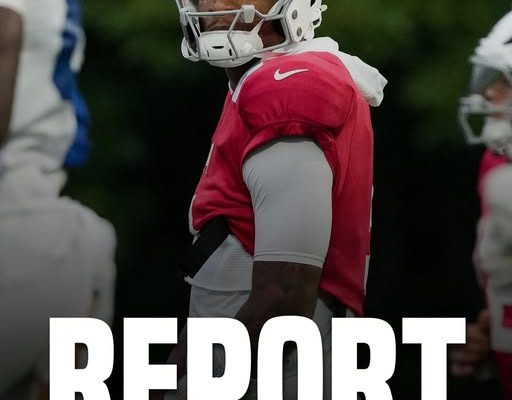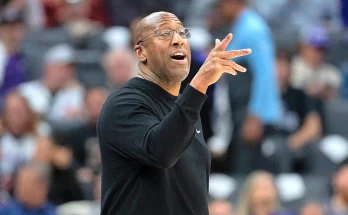The NFL has long been a league where talent, potential, and opportunity collide in a high-stakes environment, and quarterbacks often find themselves at the center of scrutiny. Anthony Richardson, the young and dynamic quarterback for the Indianapolis Colts, has become a lightning rod for debate in recent weeks. While many fans and analysts have marveled at his raw athleticism, speed, and potential to be a game-changing player, some league executives are urging caution, describing the notion of Richardson as an NFL starter as, at best, a “pipe dream.” The criticism centers primarily on his accuracy and overall readiness, sparking intense conversation about whether he can meet the demands of leading a professional football team.
Richardson’s profile coming out of the University of Florida was highly intriguing. He was known for his rare combination of size, arm strength, and exceptional mobility, making him a dual-threat quarterback who could extend plays and create opportunities in ways that most traditional pocket passers cannot. In college, Richardson demonstrated moments of brilliance, connecting on long passes, escaping pressure, and making athletic plays that electrified stadiums. His highlight reels painted the picture of a quarterback who could change the dynamic of a game with a single play. Yet, despite these physical gifts, Richardson’s college tenure was not without struggles, particularly when it came to consistency in passing, reading defenses, and maintaining composure under pressure. These are critical skills that often separate good college quarterbacks from those capable of thriving in the NFL.
The leap from college football to the NFL is notoriously difficult, even for the most talented quarterbacks. Executives point out that raw athleticism and arm talent are only part of the equation. Accuracy, decision-making, anticipation, and the ability to process complex defensive schemes quickly are equally, if not more, important. When evaluating Richardson, some league insiders have expressed concern that his mechanics and accuracy are not yet at a level where he can reliably lead an NFL offense. They worry that, without significant improvement in these areas, his natural talents may be squandered or even expose the team to repeated failures. One executive bluntly remarked, “I think it is a pipe dream right now, based on what I have seen, to say he is a starter in the NFL… The accuracy is not there.” This stark assessment highlights the gap between potential and immediate readiness, and it underscores the scrutiny that young quarterbacks face in the professional league.
Despite these criticisms, Richardson’s supporters argue that his skill set is unique and that, with proper coaching and development, he could evolve into a highly effective starter. NFL history is replete with examples of quarterbacks who struggled early in their careers but eventually flourished. Patrick Mahomes, Josh Allen, and Russell Wilson are often cited as examples of players who required time and structured development before becoming elite. Richardson’s proponents believe that, given his athletic gifts and competitive mindset, he could follow a similar trajectory, provided that the Colts commit to a tailored development plan that emphasizes mechanics, decision-making, and reading defenses at the professional level.
The Colts’ approach to Richardson’s development will be crucial. Reports indicate that the team is aware of both his immense potential and his developmental needs. The coaching staff has an opportunity to structure his playing time, practice routines, and film study sessions to accelerate his growth while minimizing exposure to high-pressure situations where mistakes could be costly. This careful balance between opportunity and protection is delicate, as too much exposure could damage confidence, yet too little could hinder the growth required to transition to a starting role. In many ways, the Colts are tasked with navigating one of the most challenging developmental arcs in recent NFL history: harnessing exceptional raw talent while correcting and refining fundamental skills under the scrutiny of fans, media, and league executives.
Critics also note that the modern NFL is less forgiving than ever for quarterbacks who struggle with accuracy and decision-making. Defensive schemes are complex, and opposing teams are quick to exploit weaknesses. A quarterback who cannot consistently deliver accurate passes risks not only game losses but also the long-term erosion of confidence within the team. Richardson’s dual-threat ability could help offset some of these concerns, as mobility and improvisation can create opportunities even when passing accuracy falters. However, executives stress that these abilities alone cannot carry a quarterback in the NFL over the long term. Precision, timing, and the ability to read defenses before the snap remain essential, and these are areas where Richardson reportedly still has significant room for growth.
Another dimension to this conversation is the mental and emotional maturity required to succeed as an NFL quarterback. Leading a professional team is as much about command, leadership, and resilience as it is about physical talent. Executives often look for evidence of poise under pressure, the ability to bounce back from mistakes, and the capacity to maintain focus during a long and grueling season. While Richardson has demonstrated flashes of these qualities, the question remains whether they are sufficiently developed to withstand the day-to-day challenges of an NFL season. The pipeline from college football to professional stardom is littered with highly talented players whose lack of mental preparedness derailed promising careers. This aspect of Richardson’s growth will likely be under as much scrutiny as his technical skills.
The media and fan reaction to these criticisms has been mixed. Some fans are alarmed, fearing that Richardson may not live up to the hype that surrounded his draft selection. Others are more optimistic, pointing to his athleticism and work ethic as reasons to believe that he can overcome early struggles. Analysts frequently highlight that the early criticism does not preclude future success, but it does create an atmosphere in which expectations must be managed carefully. For Richardson, this means that every practice, preseason game, and film study session carries added weight, as public perception can influence both internal team confidence and broader media narratives.
The debate surrounding Anthony Richardson’s readiness also reflects larger conversations about quarterback development in the NFL. There is an ongoing tension between the desire to see young players succeed immediately and the reality that quarterbacking is a highly complex and developmental process. Teams often grapple with decisions about when to start a young quarterback, how much to protect them, and when to expose them to high-pressure situations. Richardson’s situation exemplifies this dilemma: his natural talent is undeniable, but the pathway to becoming a consistent starter is fraught with challenges that cannot be ignored. Balancing patience with the urgency of winning is one of the toughest management challenges in professional football, and the Colts’ handling of Richardson could become a case study in this dynamic.
In conclusion, the discourse around Anthony Richardson’s NFL readiness underscores the complicated journey from collegiate star to professional starter. While his physical tools and athleticism are exceptional, concerns about accuracy, decision-making, and overall readiness have led some league executives to question whether he can immediately assume a starting role. The road ahead will require intensive coaching, focused development, and careful management of playing opportunities. The Colts face the challenge of nurturing Richardson’s raw potential while addressing his areas of weakness, with the understanding that the stakes are high and expectations are immense. Whether he can rise to the challenge and fulfill the promise that initially made him such a captivating prospect will unfold over the coming seasons, as the young quarterback navigates the intense scrutiny, demanding preparation, and high-pressure performance required to succeed in the NFL. His journey will likely become a defining narrative not only for the Indianapolis Colts but for the broader conversation about quarterback development, potential versus readiness, and the evolving standards of excellence in professional football. For now, Richardson remains a player of extraordinary promise, whose future hinges on growth, refinement, and the ability to transform raw talent into consistent professional success.


